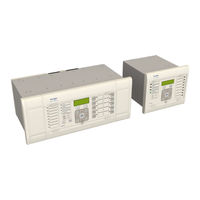GE MiCOM P144 Agile Manuals
Manuals and User Guides for GE MiCOM P144 Agile. We have 1 GE MiCOM P144 Agile manual available for free PDF download: Technical Manual
GE MiCOM P144 Agile Technical Manual (668 pages)
Feeder Management IED
Brand: GE
|
Category: Control Unit
|
Size: 21.79 MB
Table of Contents
-
Foreword
30-
Cip30
-
Nomenclature31
-
Cip31
-
-
Cip32
-
Compliance
36 -
Symbols
43 -
Front Panel
59 -
Rear Panel
63 -
-
Pcbs65
-
Watchdog69
-
Input Board74
-
IRIG-B Board76
-
-
-
Interfaces89
-
-
Password Entry101
-
Menu Structure102
-
Control Inputs104
-
Function Keys105
-
Chapter Overview
113 -
-
-
Parallel Feeders128
-
-
Cold Load Pickup
136 -
Selective Logic
139 -
-
-
IDG Curve147
-
-
EPATR B Curve157
-
-
-
Load Blinders
178 -
Chapter Overview
189 -
-
-
Chapter Overview
209 -
Chapter Overview
225 -
CT Requirements
226 -
Chapter Overview
235 -
-
-
Chapter Overview
261 -
-
-
Holding Band277
-
Chapter Overview
285 -
-
Chapter Overview
303 -
Implementation
305 -
-
CB Healthy306
-
Block AR306
-
Reset Lockout306
-
AR Auto Mode306
-
Auto Mode306
-
Liveline Mode306
-
Telecontrol Mode306
-
Circuits OK306
-
AR Sys Checks OK307
-
AR Restart307
-
Deadtime Enabled308
-
AR Skip Shot308
-
-
-
AR in Progress309
-
Successful Close309
-
AR in Service309
-
Reclose Checks309
-
Auto Close310
-
Reclaim in Prog310
-
Reclaim Complete310
-
-
-
AR no Sys Check311
-
AR CB Unhealthy311
-
AR Lockout311
-
-
-
Operating Modes313
-
AR System Checks324
-
-
Chapter Overview
337 -
Event Records
338-
Event Types338
-
Contact Events339
-
Alarm Events339
-
Security Events341
-
Platform Events341
-
-
Measurements
343-
Demand Values344
-
Fault Locator345
-
-
CB Control Logic354
-
CB Healthy Check354
-
System Checks
356-
VT Connections356
-
System Split358
-
System Check PSL360
-
Slip Control360
-
Chapter Overview
369 -
-
CTS Logic374
-
-
Resistor Values376
-
Chapter Overview
383 -
Scheme Logic
385 -
Function Keys
392 -
Control Inputs
393 -
Chapter Overview
397 -
Introduction
398 -
-
Direct Tripping399
-
-
Implementation
400 -
Configuration
401 -
Chapter Overview
409 -
-
Data Protocols
436-
Courier436
-
Courier Database437
-
Setting Changes437
-
Event Extraction437
-
Iec 60870-5-103441
-
Initialisation442
-
Commands442
-
Test Mode443
-
Dnp444
-
Modbus456
-
MODBUS Functions457
-
Response Codes457
-
Register Mapping458
-
Event Extraction458
-
Setting Changes467
-
Iec 61850471
-
-
Read Only Mode
476 -
-
Sntp479
-
PTP Domains480
-
Overview
483 -
Standards
485-
NERC Compliance485
-
Cip 002486
-
Cip 007487
-
Ieee 1686-2007487
-
-
-
Blank Passwords491
-
Password Rules491
-
Logging out498
-
Chapter Overview
501 -
-
Terminal Blocks506
-
RS232 Connection509
-
-
Case Dimensions
510 -
Chapter Overview
515 -
-
Test Mode Cell518
-
Test Leds Cell518
-
Product Checks
522-
Insulation523
-
External Wiring523
-
Power Supply524
-
Test LCD525
-
Date and Time525
-
Test Leds526
-
Test Trip LED526
-
Test Opto-Inputs526
-
Setting Checks
531 -
Onload Checks
535 -
Final Checks
537 -
Chapter Overview
541 -
Maintenance
542-
Alarms542
-
Opto-Isolators542
-
Output Relays542
-
Replacing Pcbs545
-
Recalibration548
-
Battery Disposal549
-
Cleaning549
-
Troubleshooting
550-
Power-Up Errors550
-
Backup Battery552
-
Chapter Overview
557 -
Interfaces
558-
Rear Serial Port558
-
-
-
Load Restoration571
-
-
General574
-
Fault Locator574
-
-
Ratings
575 -
Type Tests
581 -
-
Power Frequency585
Advertisement
Advertisement
